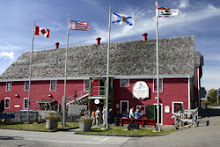Hello Everyone,
The Fisheries Museum of the Atlantic is perched on the edge of Lunenburg’s front harbour. In fact, we’re actually out over the edge, between land and sea, with some of our buildings and the wharves. Our largest vessels, the schooner Theresa E. Connor and the trawler Cape Sable, float alongside, at dock.
Lunenburg really does offer the best of both worlds: history is alive within this UNESCO World Heritage Site and modern technology thrives, with businesses such as HB Studios and Composites Atlantic.
Given that this is not the land where time stood still, it is heartening to look out at the harbour and see authentic Lunenburg dories being rowed. The young women and men who practice their rowing skills in the dories are doing it for many reasons, including the International Dory Races, which are held each year.
The Lunenburg Dory is as essential to the story of the schooner fishery as the larger vessels themselves. Dory fishing changed the landscape of Lunenburg and all coastal communities that were involved in the schooner fishery.
Although there is scholarly debate in terms of when dory fishing began, the date is usually set in the 1850s. As late as the 1830s-1870s, fishermen fished from the decks of the schooners, each using one or two long fishing lines. This began to change on this coast in the 1850s, when enterprising American fishermen began to go out in dories, from the mother schooner. This was called "single dory fishing", as each dory contained only one fisherman. They still fished with one to three lines (one would be tied to a tholepin).
In the 1860s, double dory (larger dories with two men) fishing changed the schooner fishery forever. Instead of a few lines, with one or two hooks each, fishermen now set long lines of trawl, with thousands of hooks per dory. The resultant economic boom in the fisheries meant that communities enjoyed financial rewards far beyond anything that had gone before that time.
In Lunenburg, double dory fishing began in 1873, with Captain Benjamin Anderson at the helm of the schooner Dielytris. He took four dories and a crew of 13. Four other vessels were similarly equipped and went with him to the Western Banks, near Sable Island. The companion schooners went home, quickly disheartened with the experiment. Captain Anderson stayed on and had a very successful fishing trip.
Dory fishing caused such a dramatic change in the industry that Lunenburg went from a fishing community with 15 schooners, in the mid-1800s, to a thriving port that was home to more than 100 schooners at the turn of the 20th century.
Wishing you Smooth Sailing,
Heather
Thursday, February 7, 2008
Subscribe to:
Post Comments (Atom)

No comments:
Post a Comment